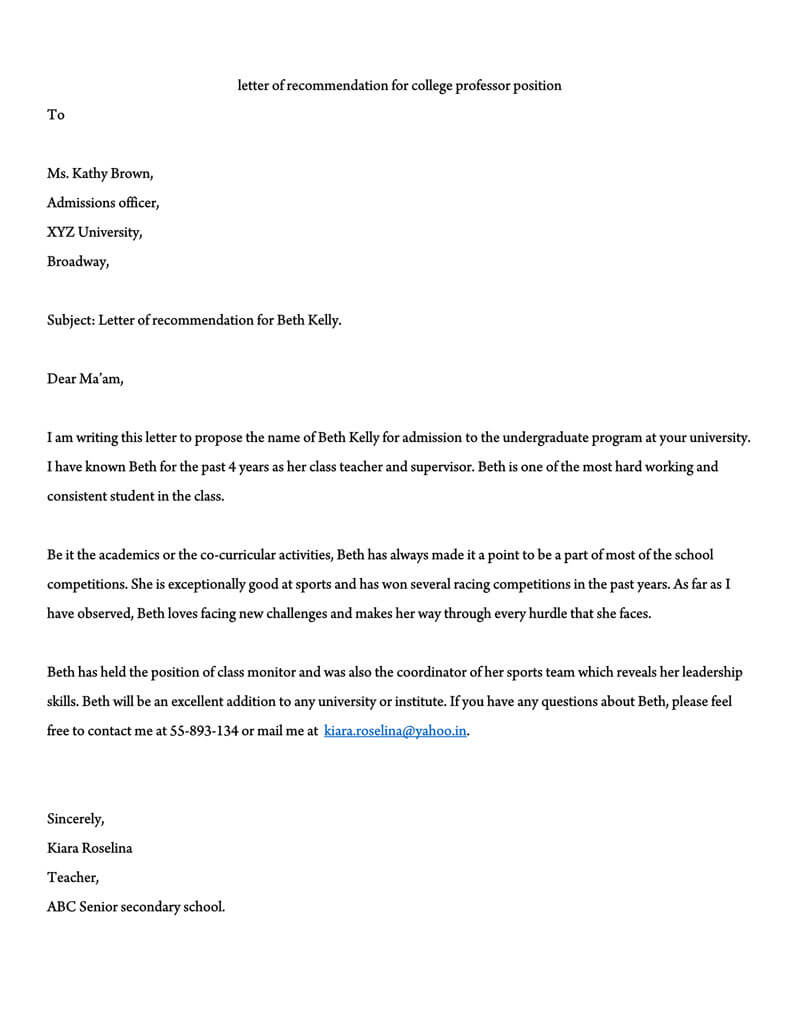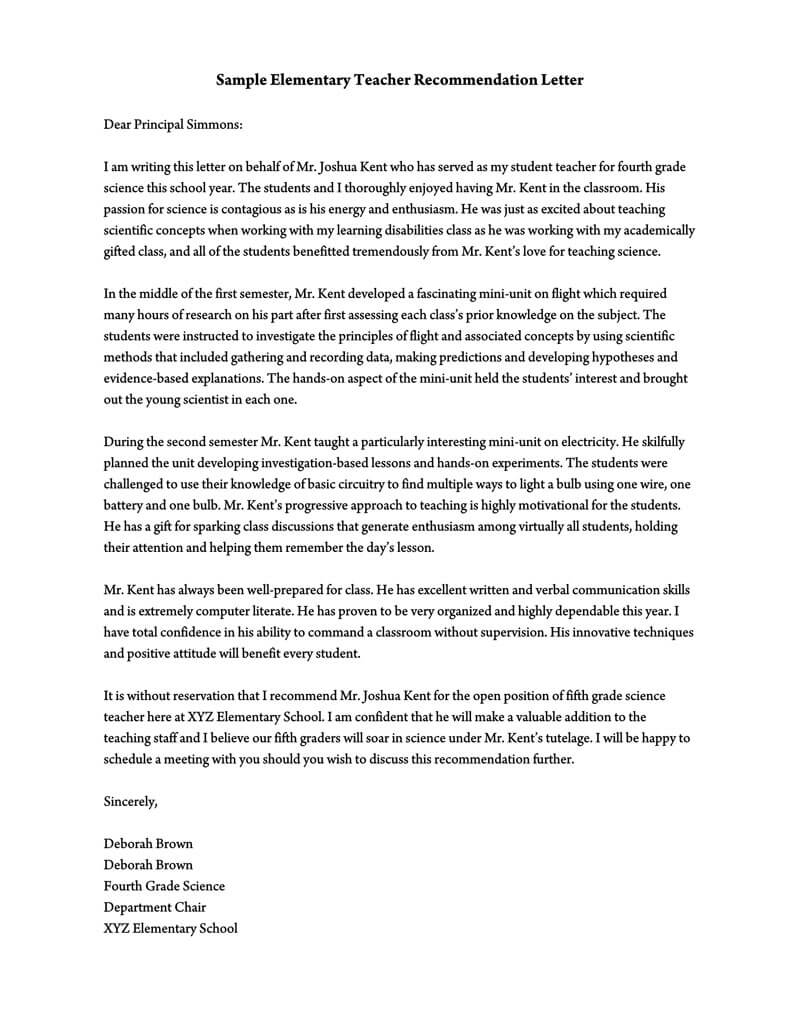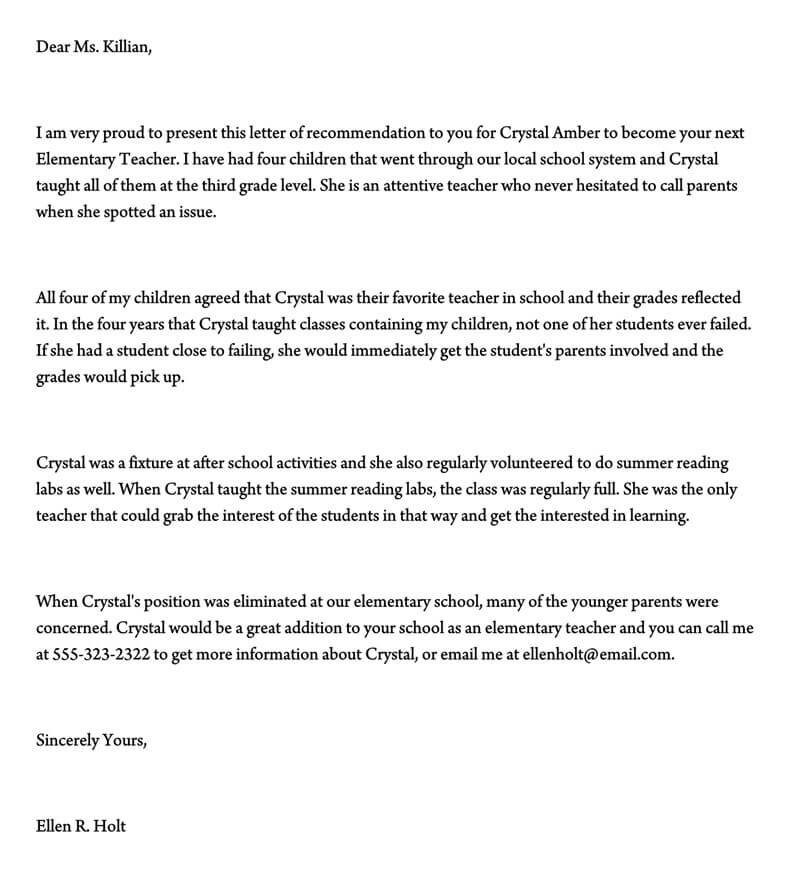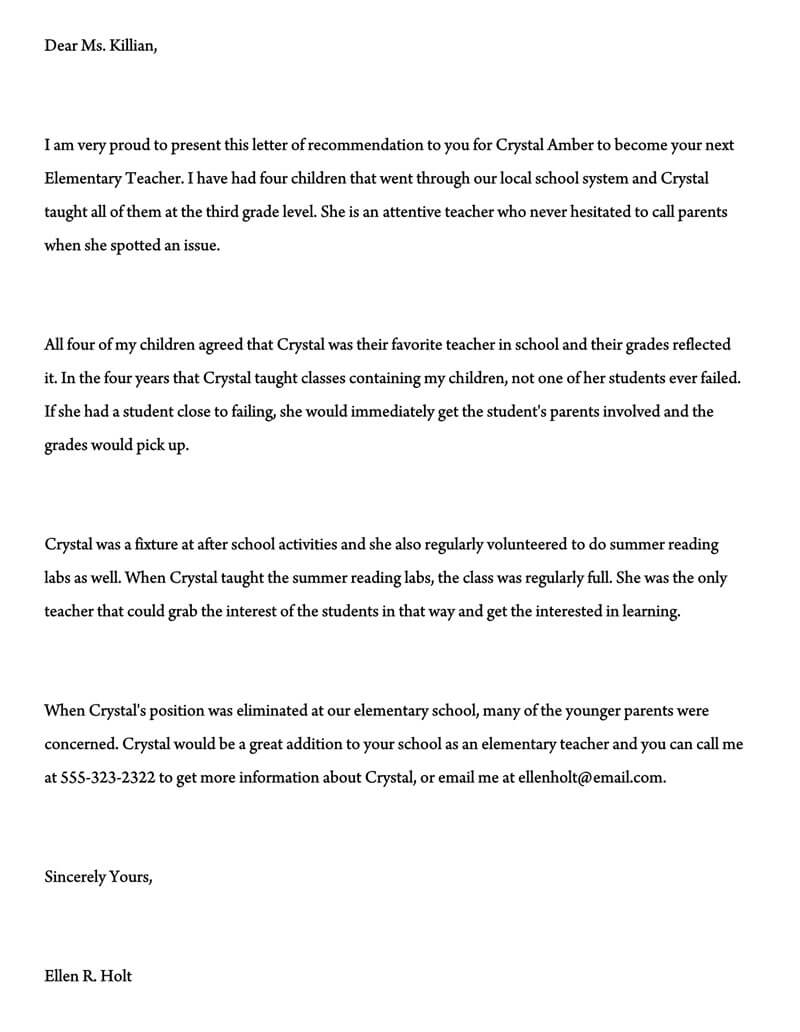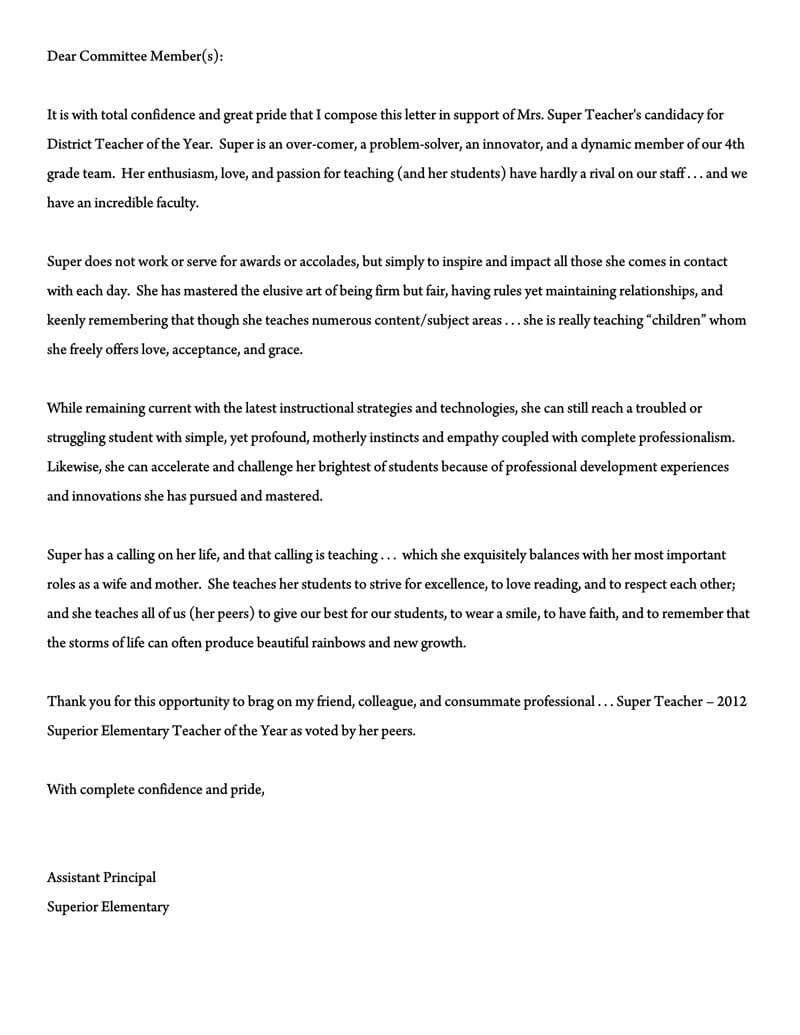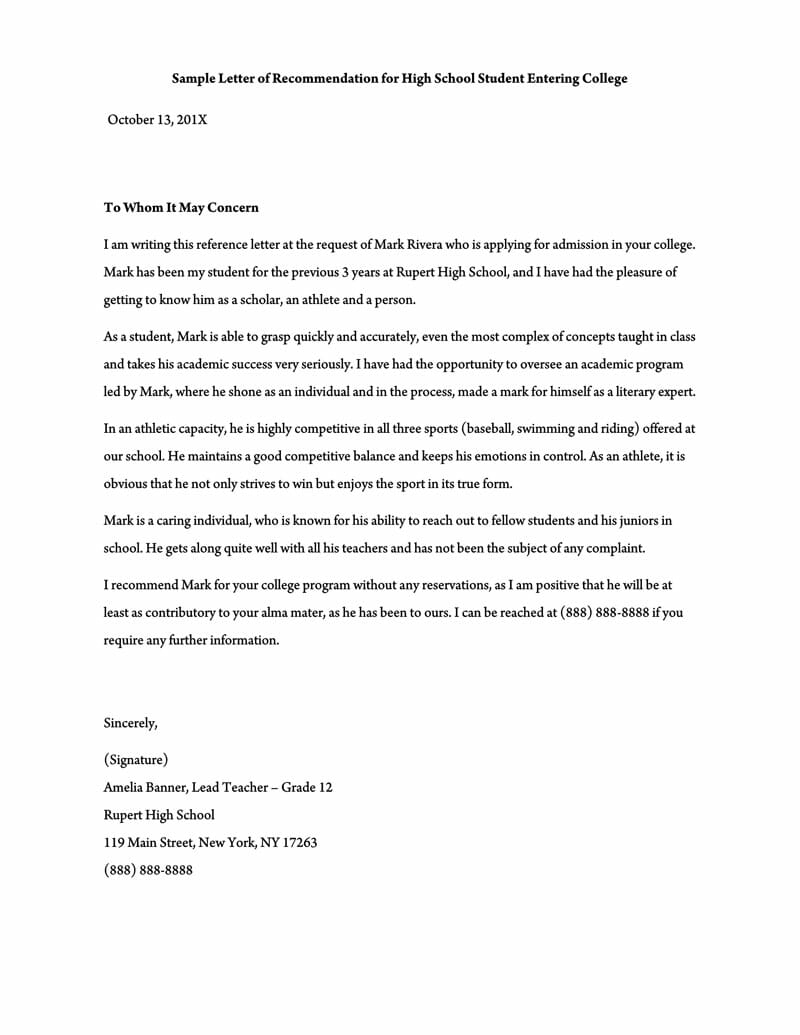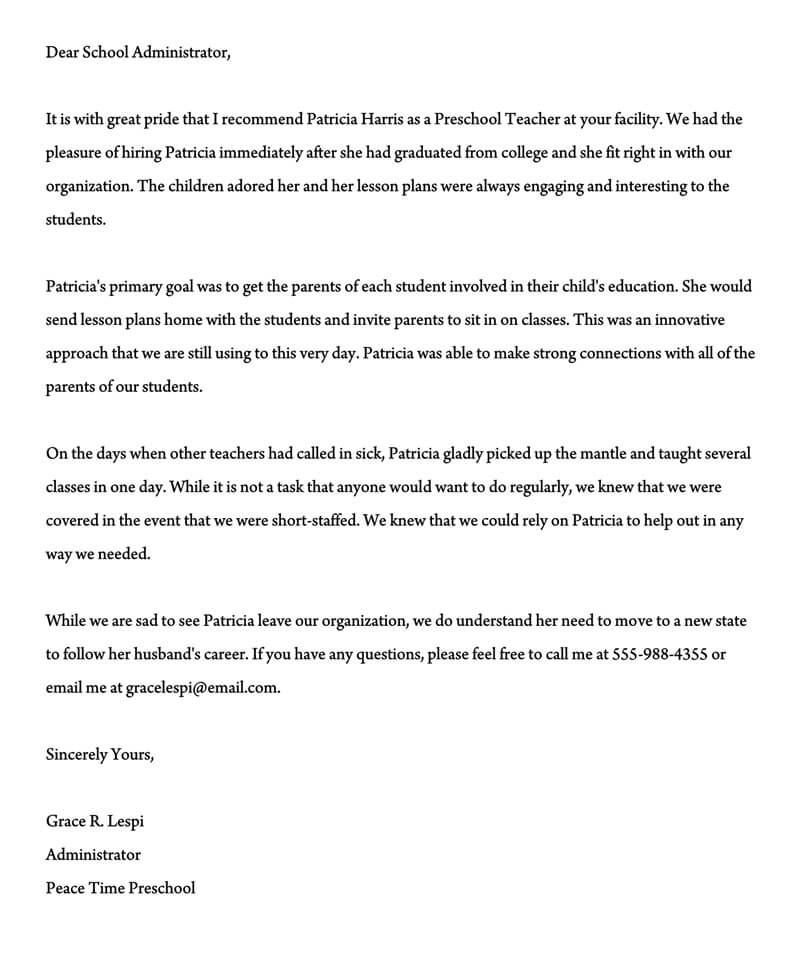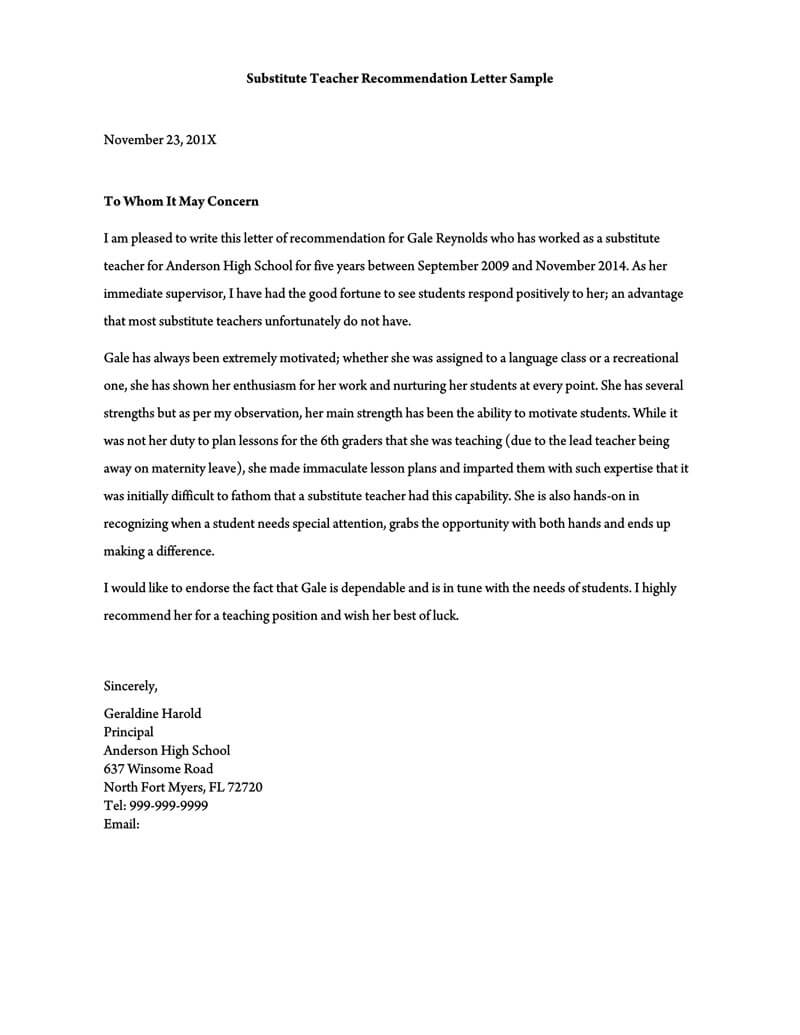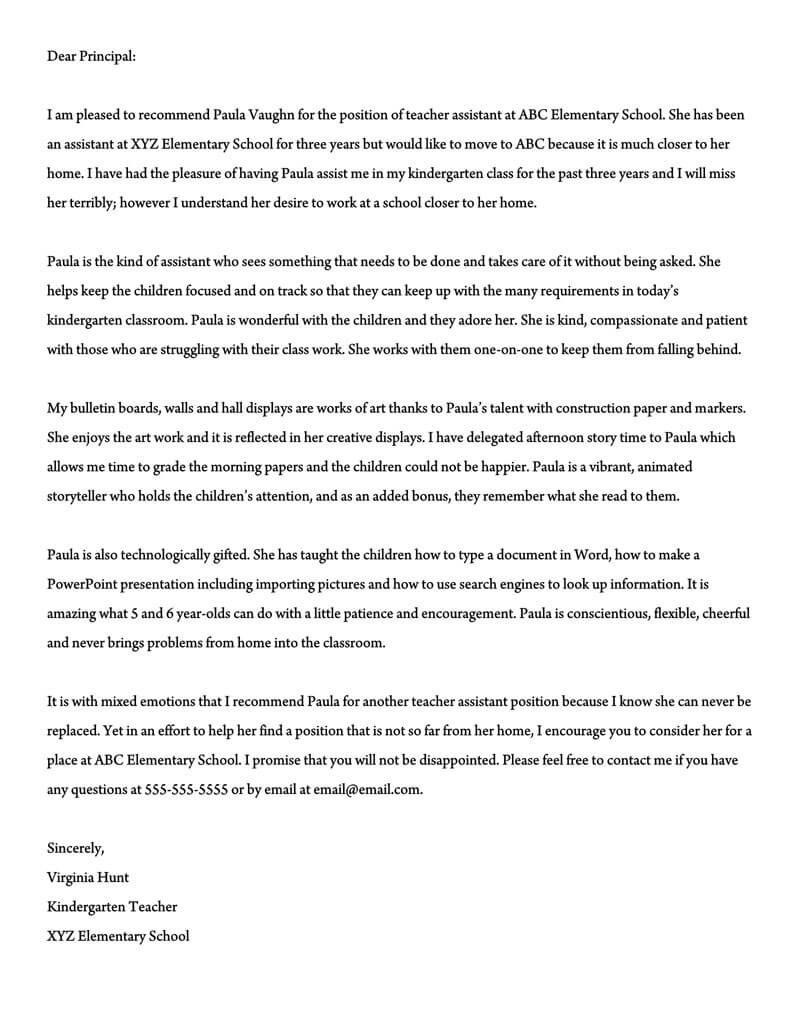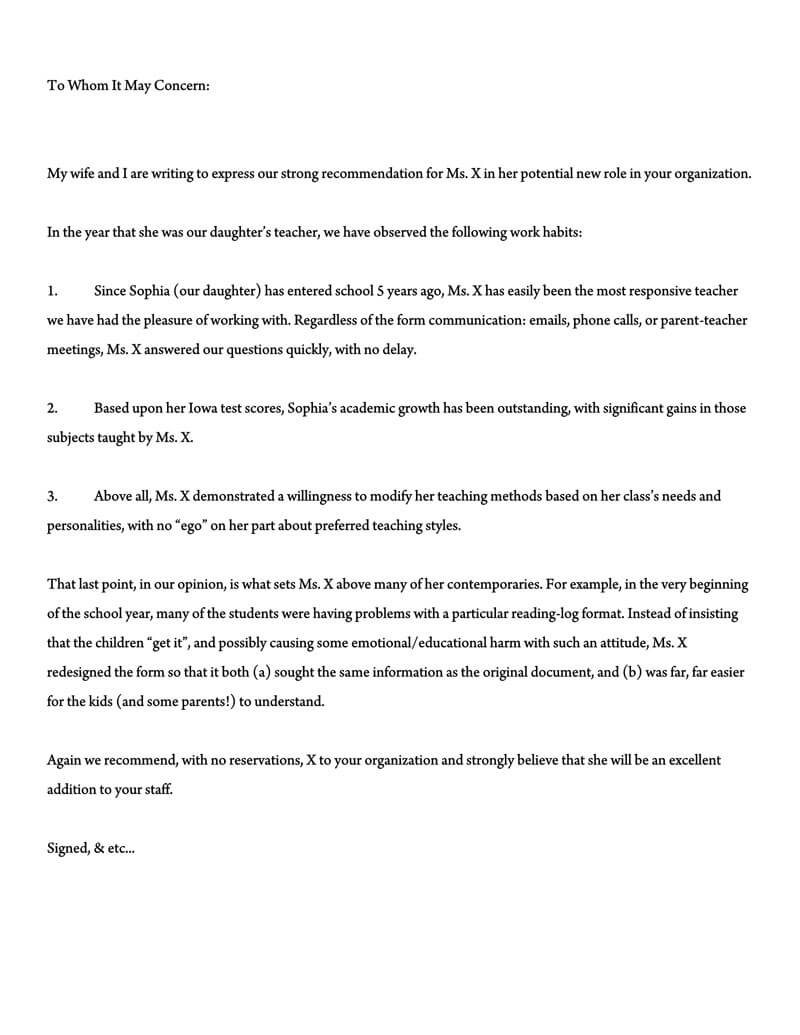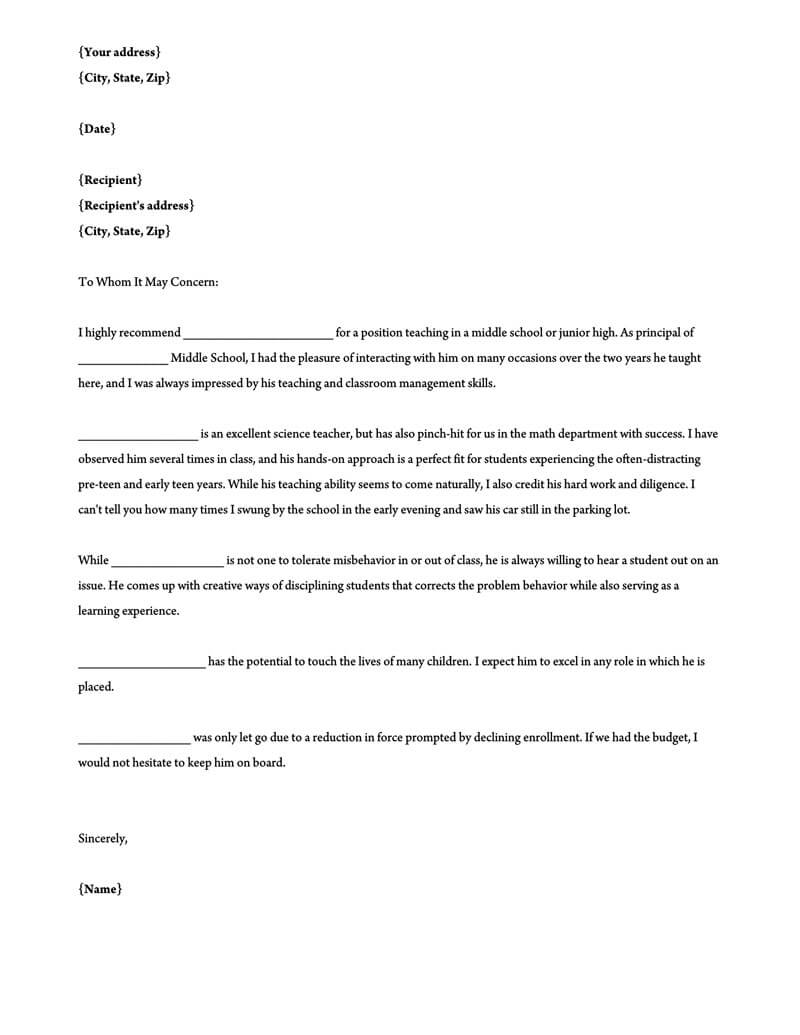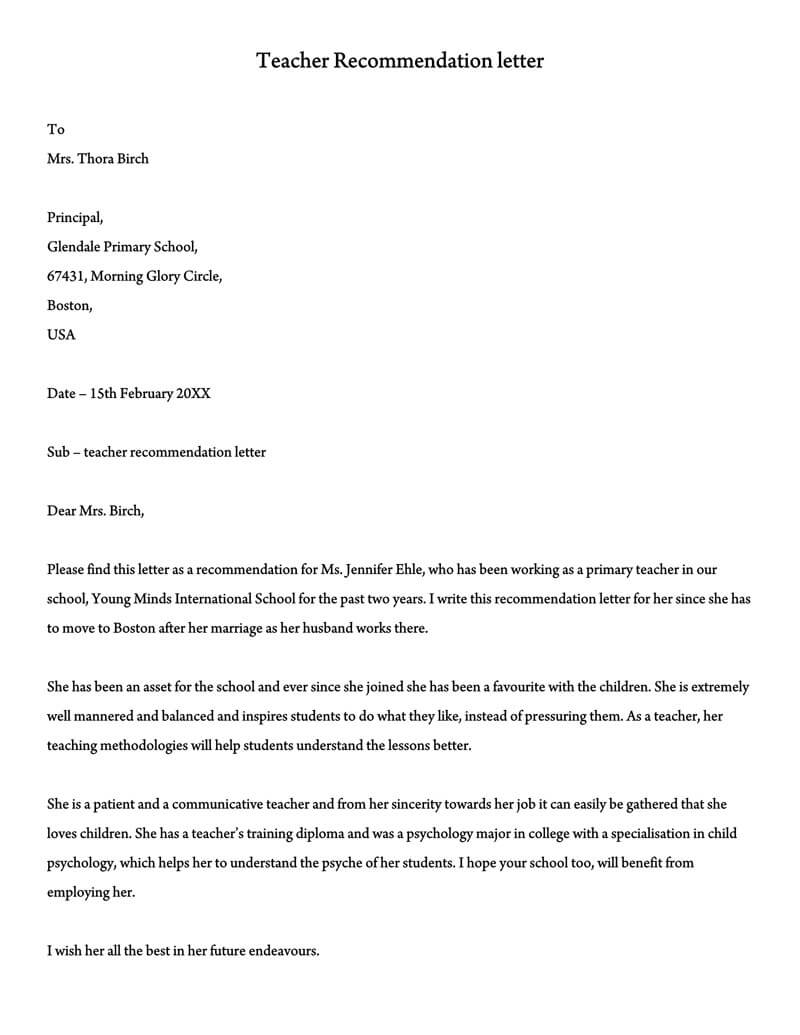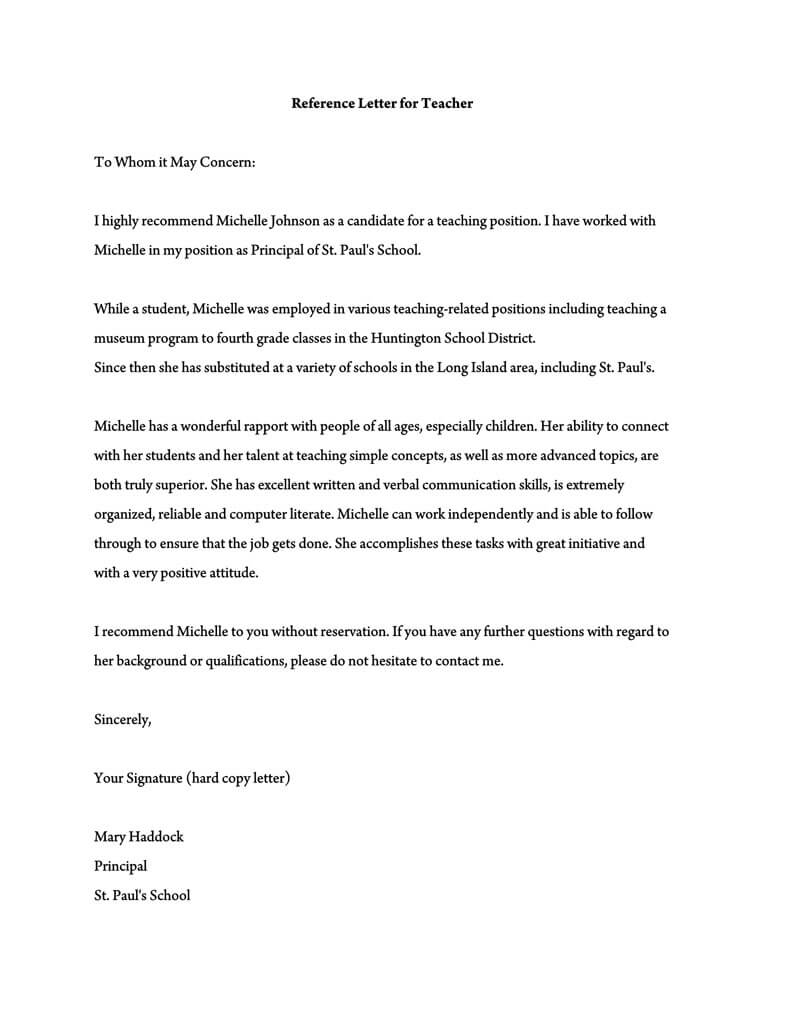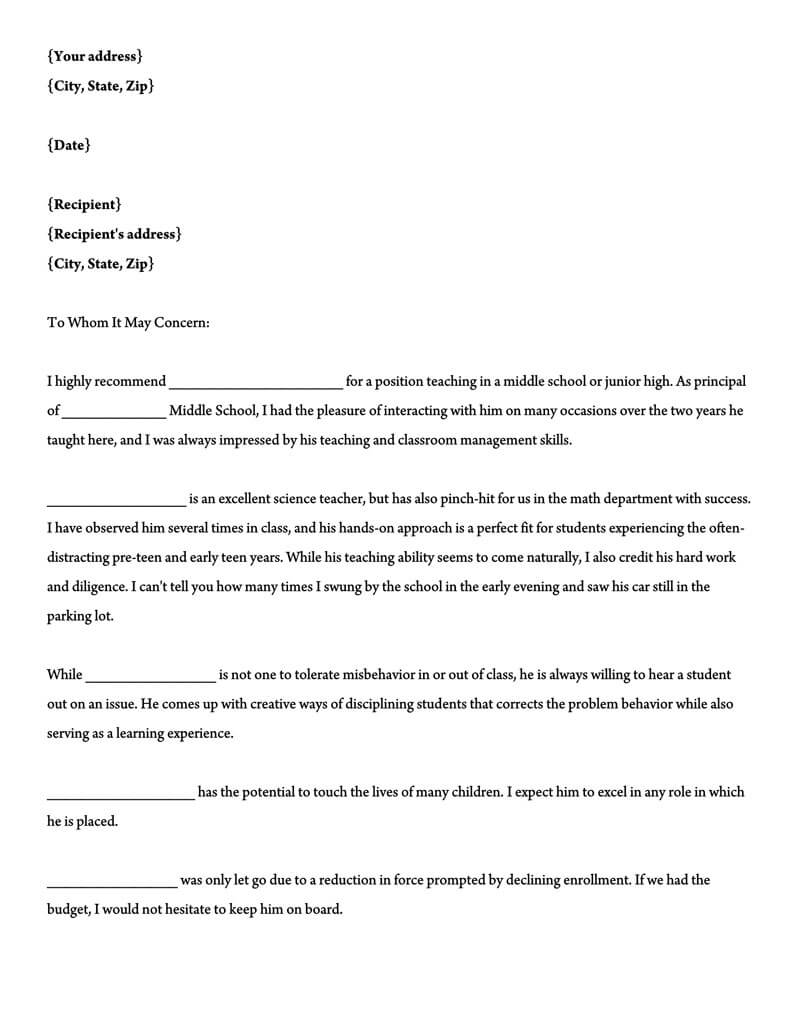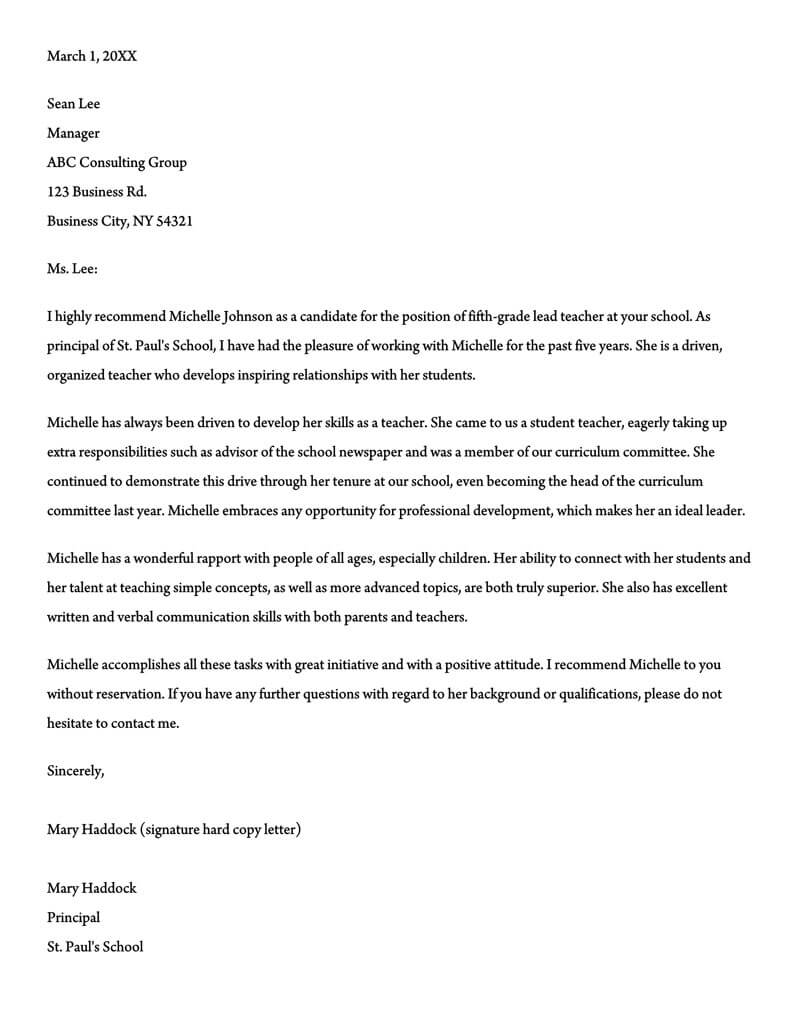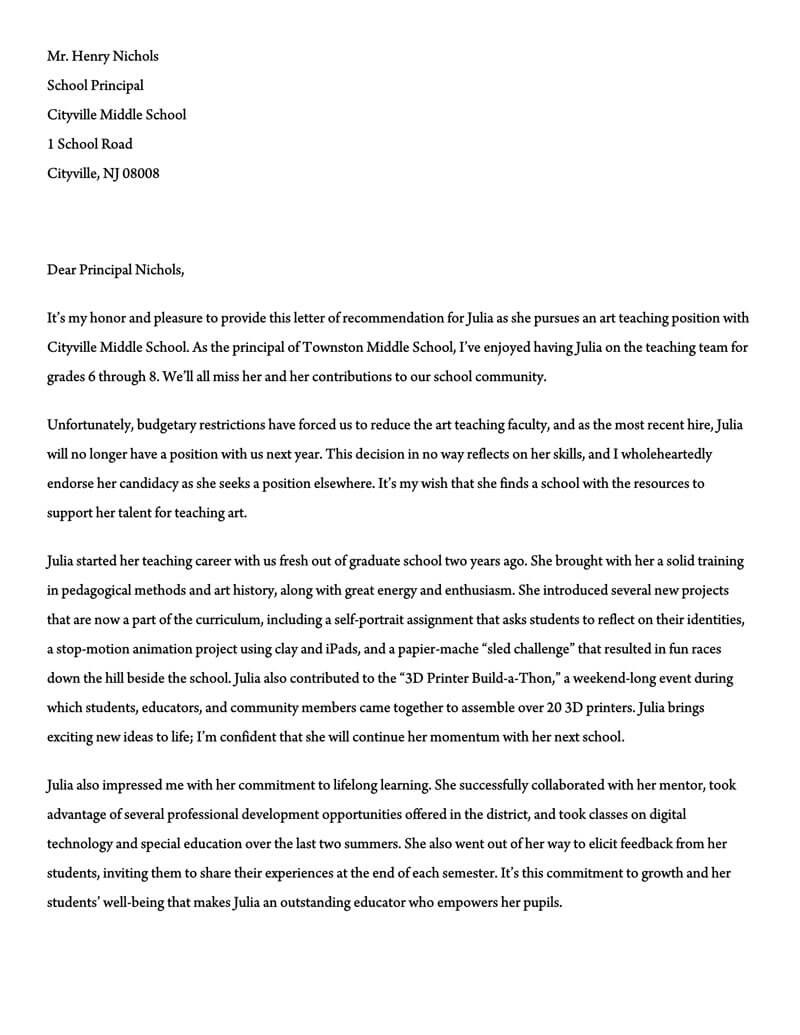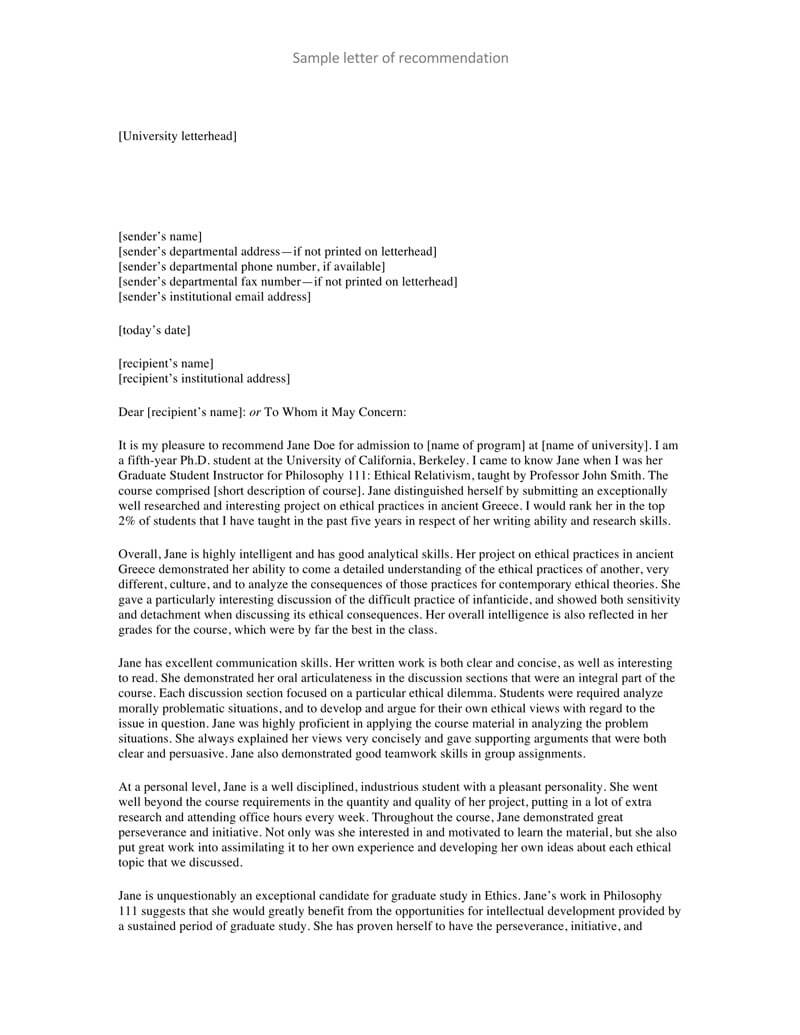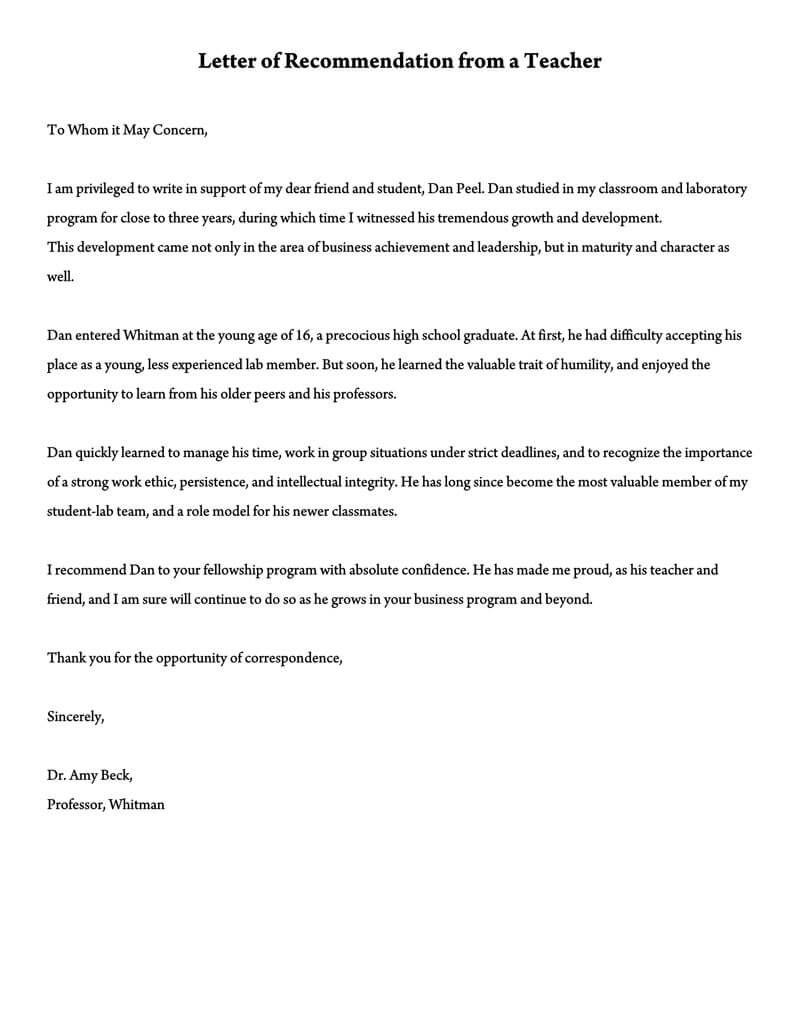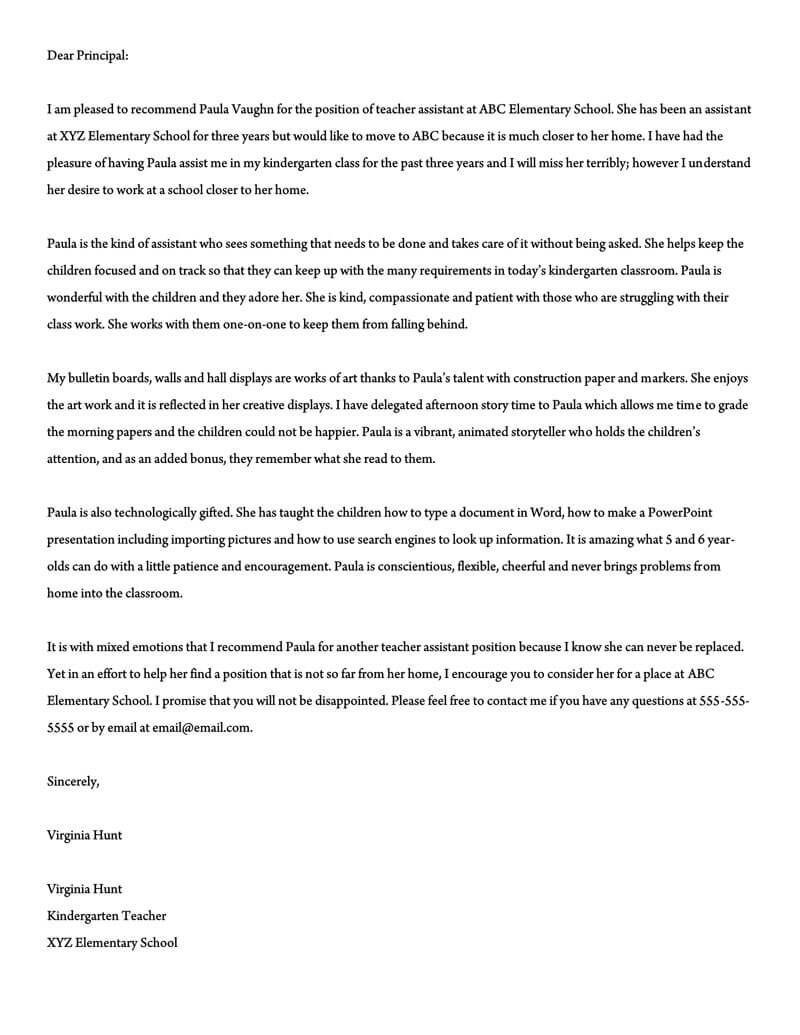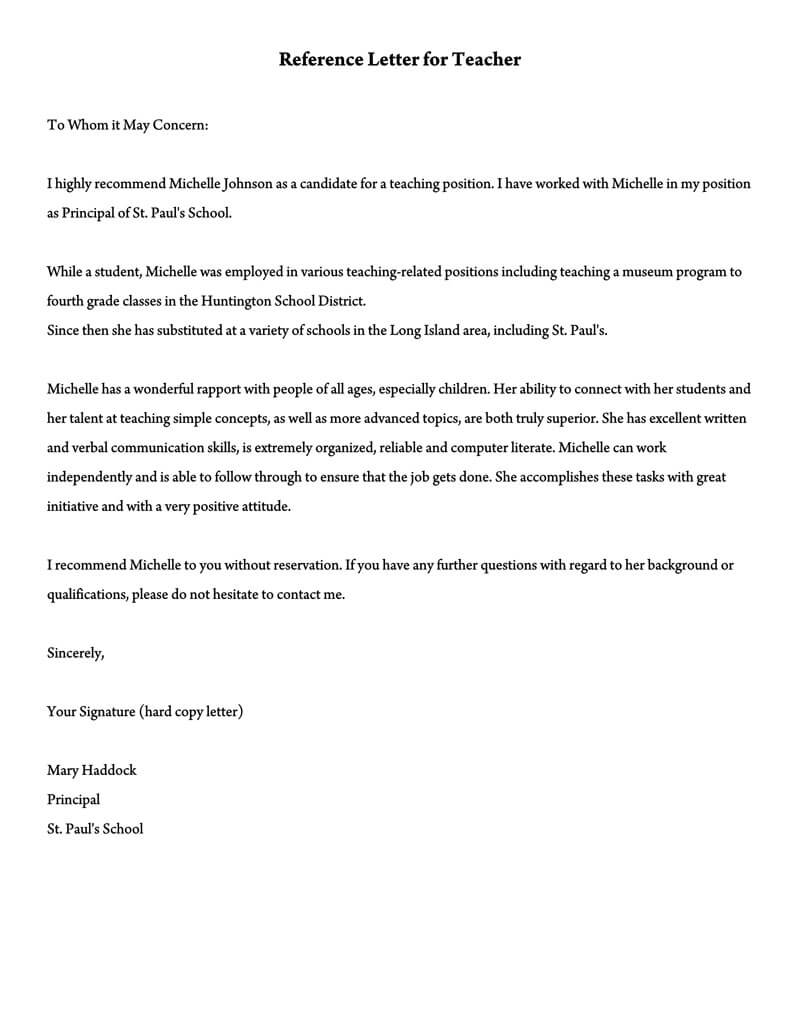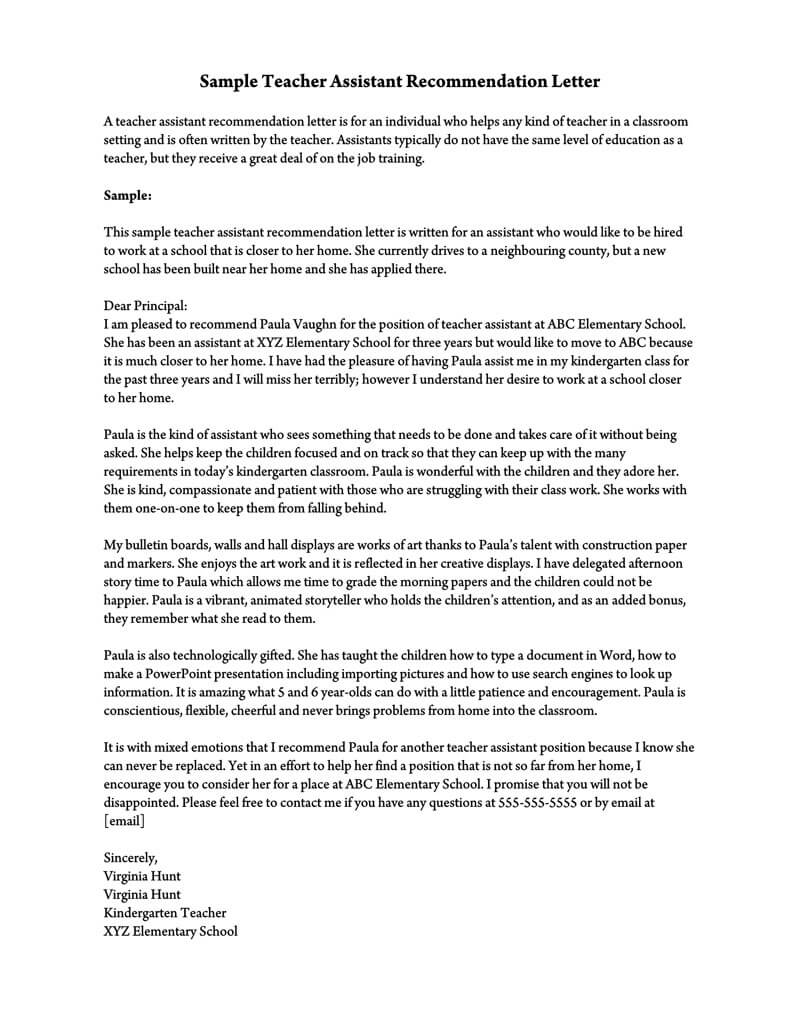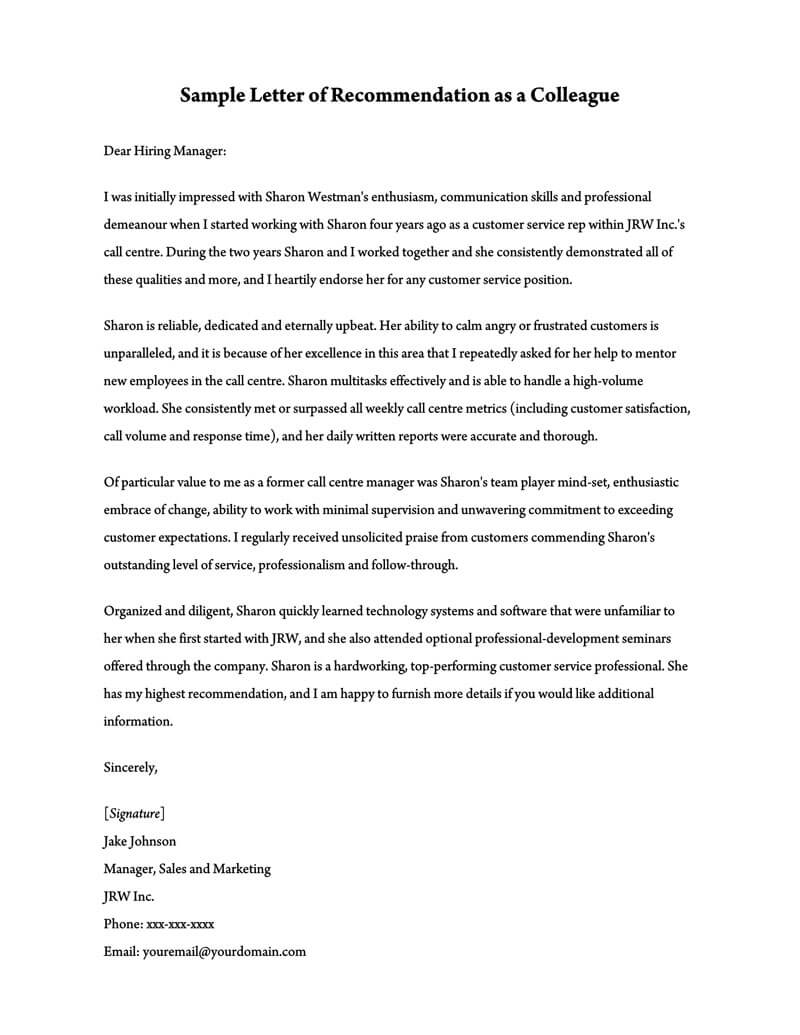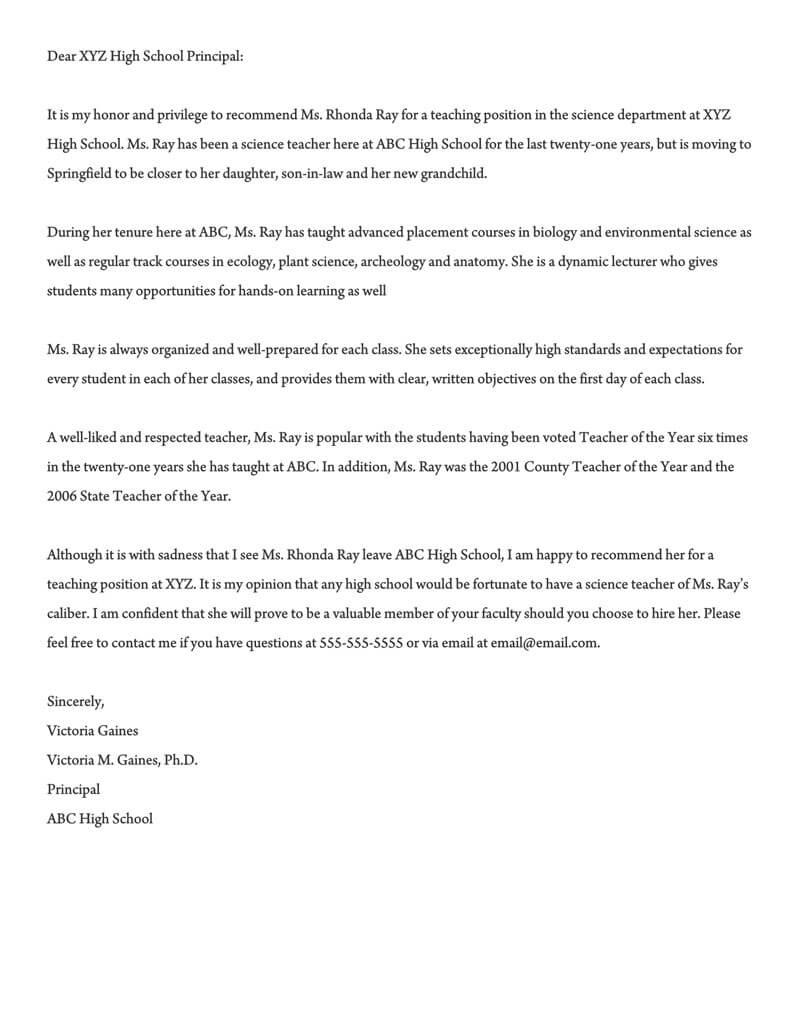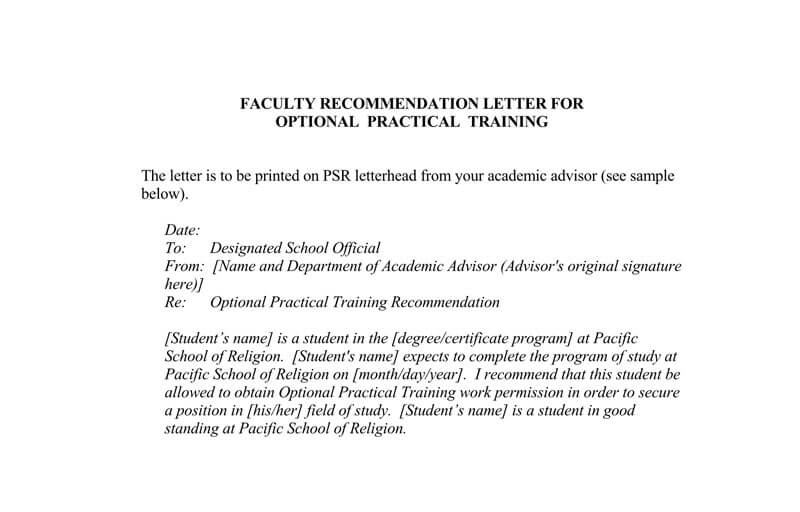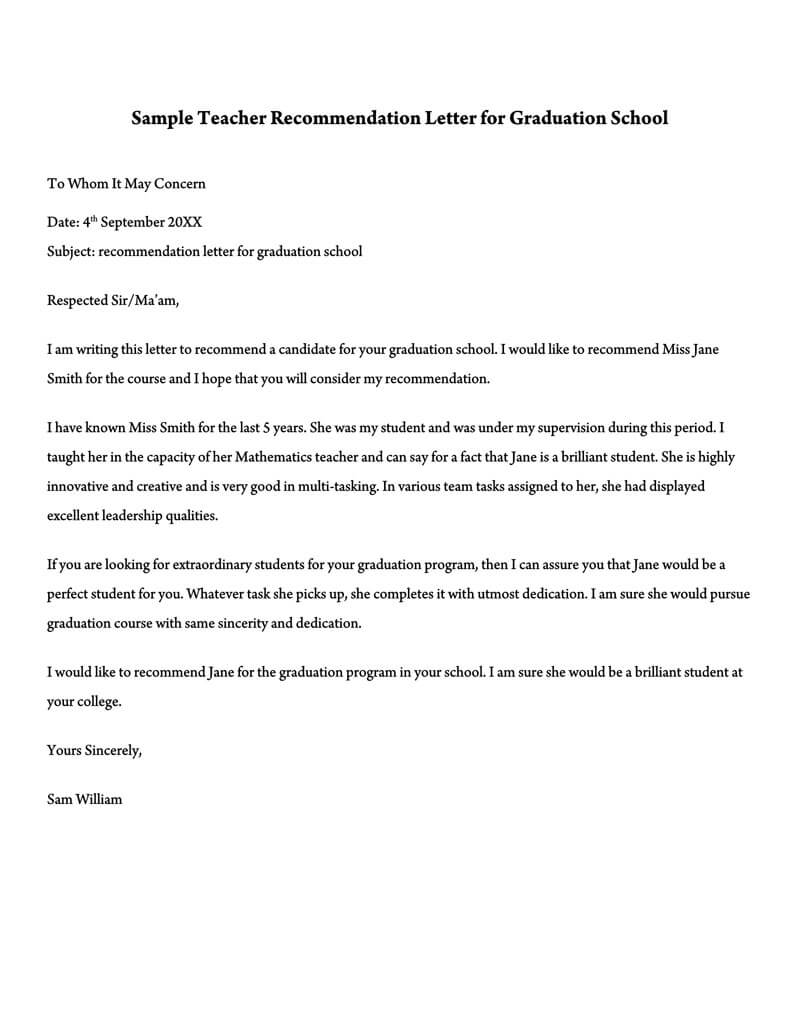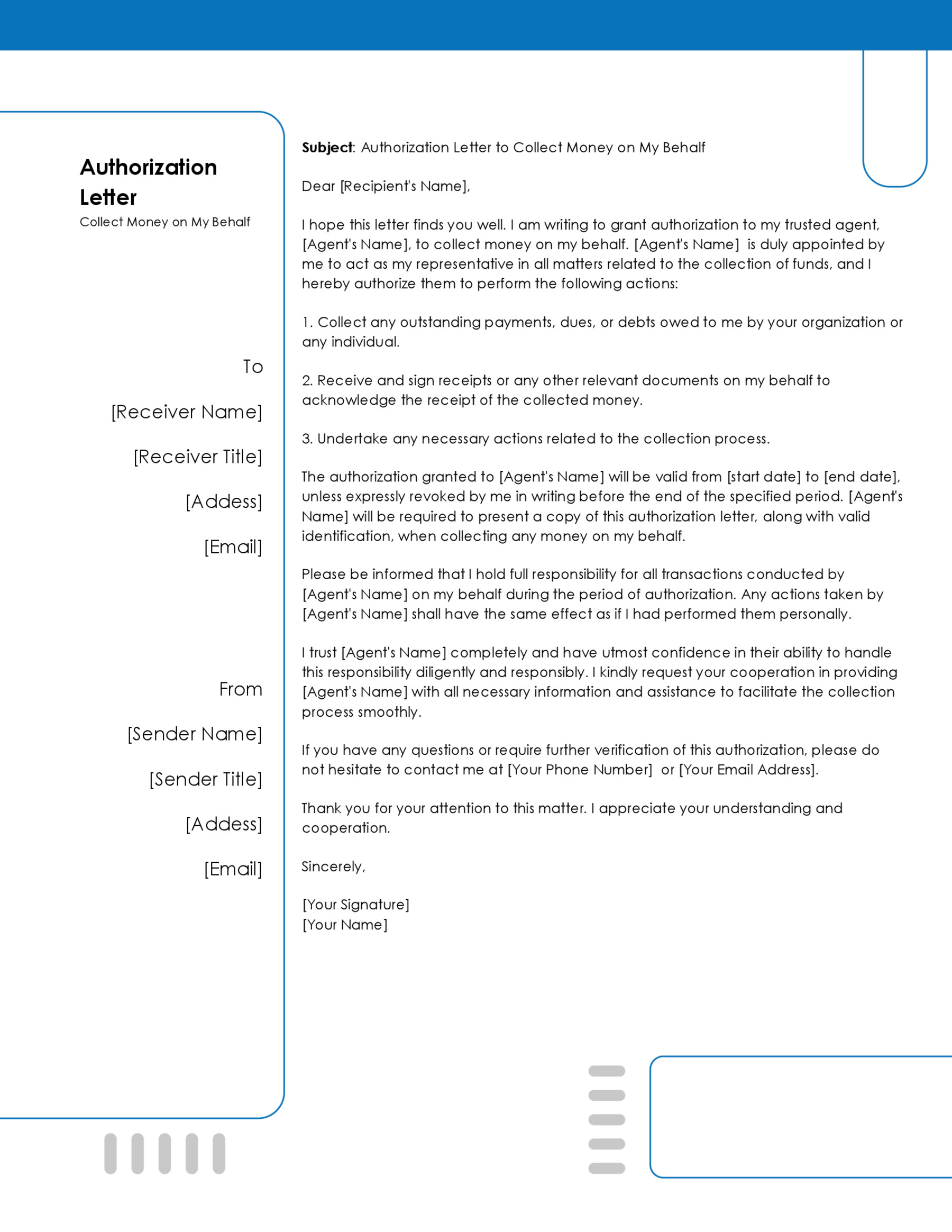A recommendation letter for a teacher is a formal document used to validate a teacher’s resume or credentials.
It provides information on the teacher’s characteristics, qualities, and capabilities.
Teachers with no experience, such as recent graduates, use recommendation letters to help strengthen their resumes. It can also be used by teachers who are applying for positions at universities or colleges to help them get into teaching programs or educational institutions.
This letter can also be used by experienced teachers applying for higher-level positions. The letter, in this case, can be used to help advance the teacher to a higher position.
Letter Templates
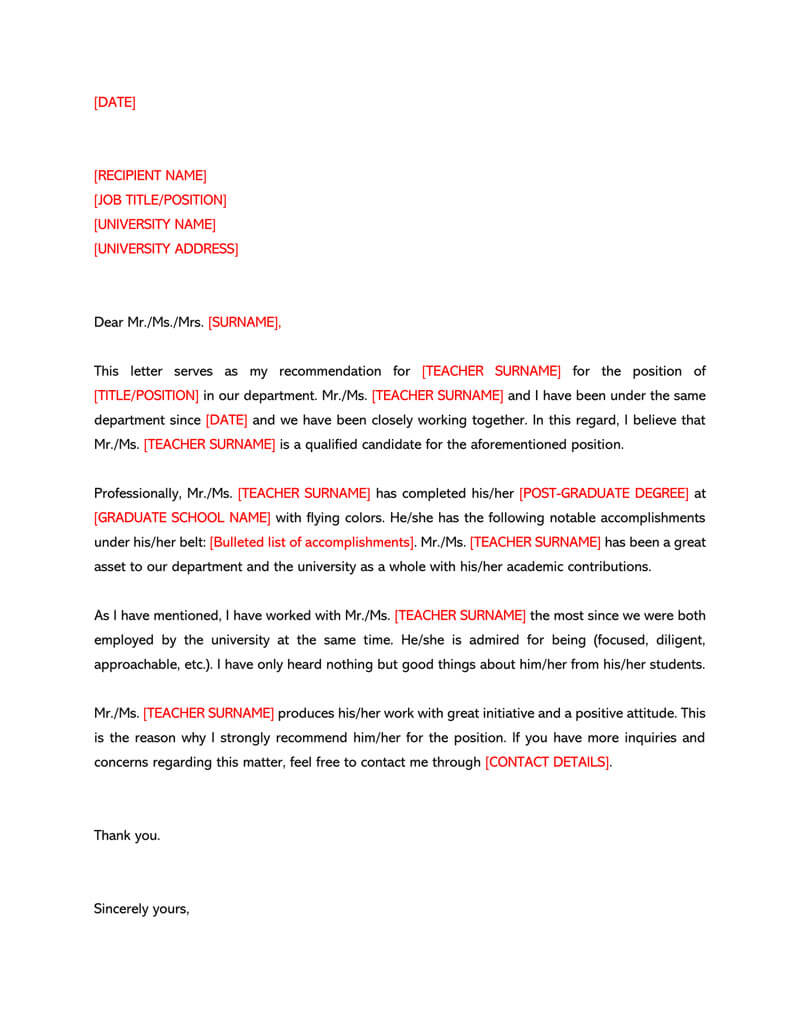
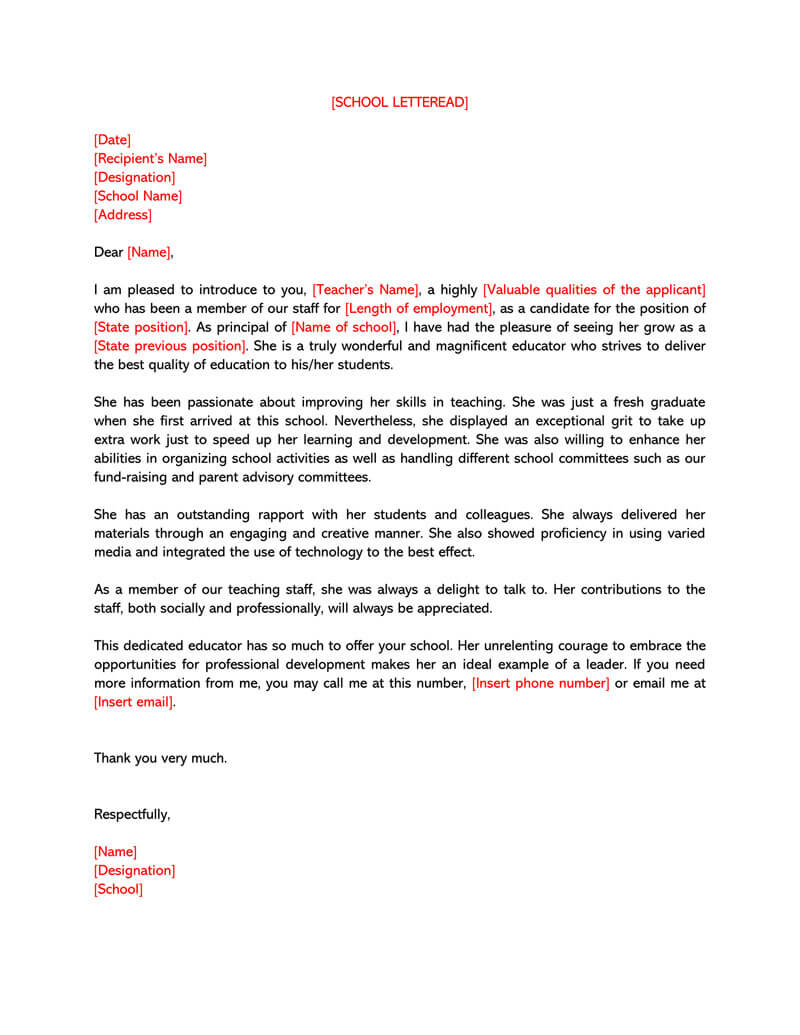
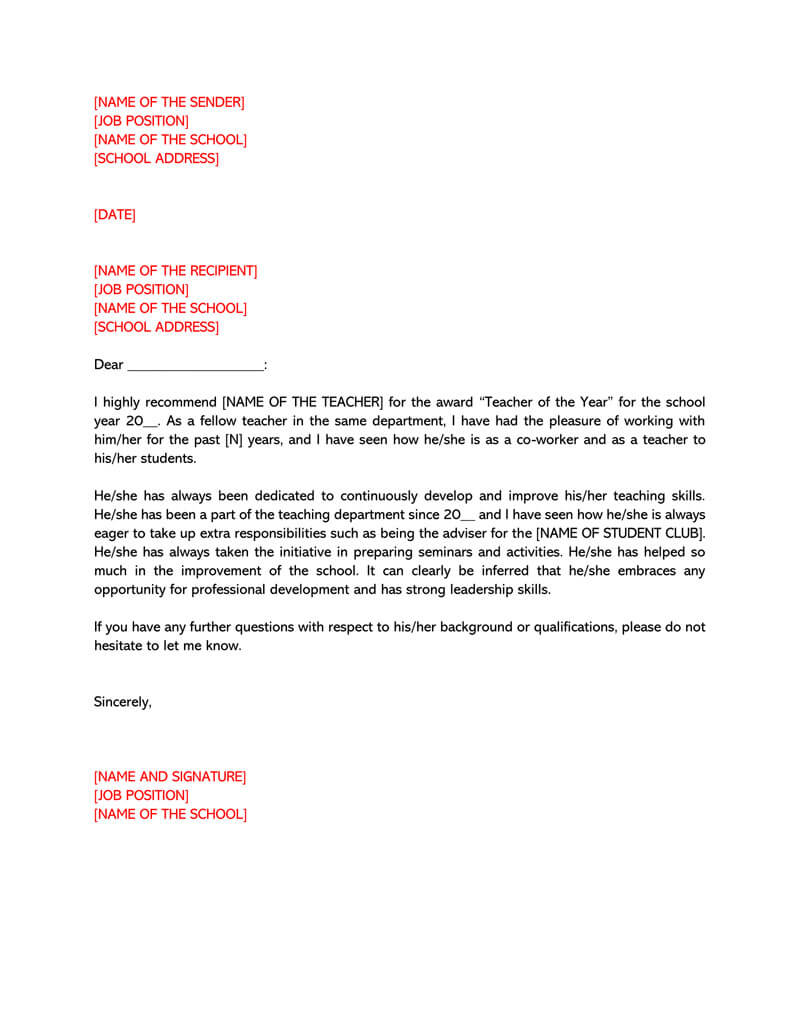
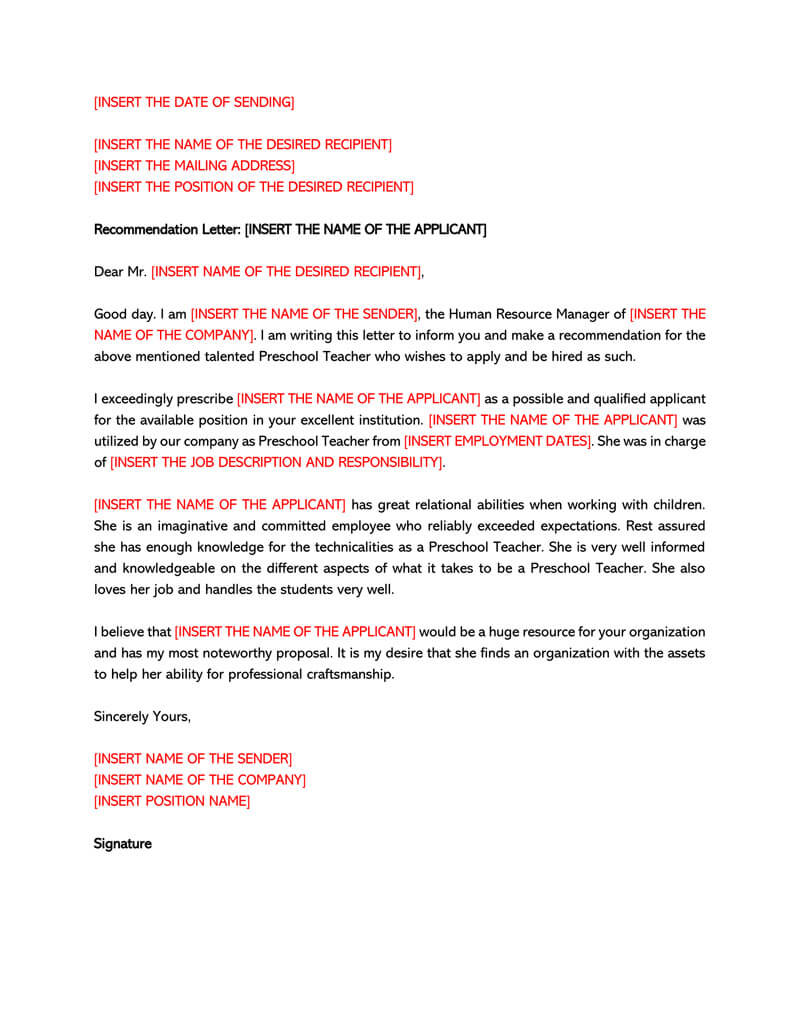
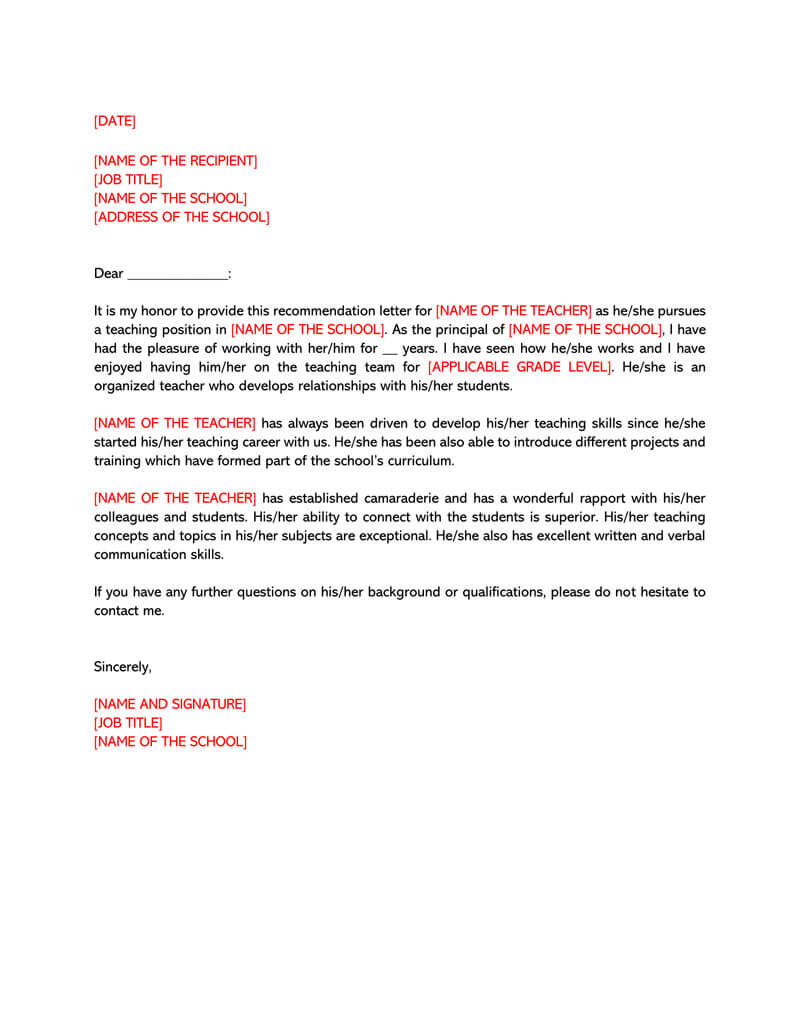
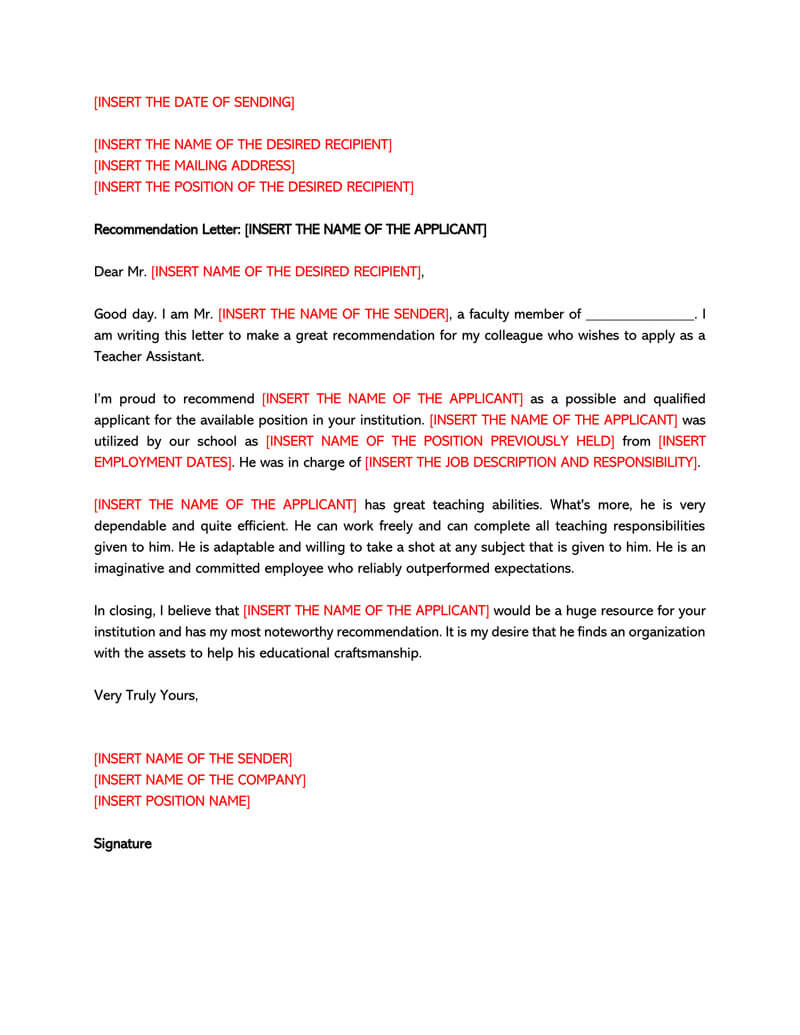
First Things first: Who Can Write a Letter of Recommendation?
Some job postings specify that you must be a direct supervisor to the teacher to write a letter of recommendation. If this is the case, a present or former principal, vice-principal, school head, director, or someone of similar caliber would be required to write the letter.
Generally, however, anyone can write a letter of recommendation. Most often, teachers ask trusted colleagues to write these letters for them. This can include mentors, members of the same team, principals, or even classroom assistants. It is usually best to request someone write the letter with whom you have a strong, professional relationship. Use your best judgment.
For example, if you are unsure whether someone is qualified to write you the letter (or if you are the writer and you are unsure whether you should be the one writing the letter), you should probably ask another colleague to write your recommendation. You should never have to question what may be said in the letter, especially if you will not be seeing the letter before it is sent away to a potential employer.
What Information Should You Ask Your Colleague Before You Start Writing?
The first thing that you should ask your colleague is who you should be addressing the letter to. Professional letters follow a specific format and include the name and address of the person who will be receiving the letter. If your colleague does not know whom the letter should be addressed to, ask them about the school and the position they will be applying for. If you have this information, you can do your due diligence.
Looking at the job posting on the school’s website usually specifies who should be contacted to apply for a position. If it does, make sure that the letter is addressed to this person, instead of utilizing a generic “To Whom It May Concern”.
Another important piece of information to have from your colleagues is what position they are applying for. This helps to further tailor the letter. By knowing the position for which they are applying, you can better speak to the accomplishments and experience of the person you are writing for.
It is also acceptable to ask them for their resume, especially if you have known the person only in the setting of their current school. Many resumes include a list of achievements that people have reached during their time in specific positions. You can use these to your advantage when writing your recommendation.
How do you format it?
These letters should always be formatted professionally. There are templates that you can utilize to write these in programs such as Google Docs and Microsoft Word, or you can find a template below. There is no one tried and true way to write a letter, however, all professional letters follow strict formatting rules that adhere to business standards. We are including an example below for your convenience!
How to Craft a Recommendation Letter for a Teacher
A colleague writing it for a teacher is in the best position because he/she has worked with the applicant. A fellow teacher provides a perspective that the resume and cover letter may not provide. Therefore, it must be well structured to ensure that all the necessary information is captured.
A recommendation letter must therefore contain the following information within its structure:
Section 1: Letterhead
The letterhead should be written at the top left corner of the letter. It provides all the relevant information concerning the sender. The information includes:
Date of writing
Colleagues writing the letter should start by indicating the date of writing. The date of writing plays an important role for the recipient by letting him/her know when it was written.
Full name
The recommending teacher’s full name should be stated. The full name identifies who the writer of the letter is.
Title
It should also contain the writer’s role in the school where he/she works. The writer can state titles including teacher, head of the department, principal, etc.
School name
Teachers writing it for a colleague must also state the name of the school /institution where he/she works. This helps the recipient easily contact the recommender.
Complete address
The complete school address must be indicated by the writer. The address should contain the city, state, and zip code.
Preferred contact (optional)
The recommender may also include his or her contact information on the letterhead. The information may include an email and a contact number that the recipient may use to contact the recommender.
Section 2: Introduction
The introduction of the letter should contain the following information:
Name and address
The recommender must state his/her name as well as the recipients. In addition, their complete address, containing the city, state, and zip code, must also be entered.
Professional greeting
The recommender must then state a professional greeting to the recipient. After that, the recommender can address the recipient directly, which demonstrates personal initiative. However, if the recipient is unknown to them, the recommender can address the letter, ‘To whom it may Concern.’
Introduce the applicant
The introductory section of the letter should also contain the name of the applicant. This helps the recipient identify the applicant that the recommender is writing about.
Section 3: Body
The letter’s body should contain several paragraphs concerning the applicant, depending on how well the two colleagues are acquainted. A recommender with a strong relationship with the applicant should ensure that the body of the letter contains the following information:
State your qualifications
The body of the letter starts by stating the qualities possessed by the applicant. The qualities stated should be written based on the recommender’s observation of the applicant.
Your positive assessment of the applicant
It must contain a positive, impactful assessment of the applicant. The assessment should include the following information:
The applicant’s role and position in a school
Colleagues writing the letter should also state the role played by the teacher in the school and any position he/she occupies. They can state that the applicant is, for example, the coach of the athletics team, etc.
Training and skills
Information on the applicant’s training and skills should then be provided. The teacher should ensure that the information provided is relevant to the position; for example, a teacher applying to work in kindergarten should be patient, flexible, and have relevant certifications such as a certified college or university degree.
Contributions
It should also contain contributions made by the applicant to depict his/her ability to go beyond the job description. The contributions stated should have a long-lasting impact on the school community.
Student-teacher tasks and responsibilities
The recommender should demonstrate student-teacher tasks that illustrate the applicant’s work ethic and ability to work productively with the students. The recommender should also state the applicant’s ability to carry out his/her responsibilities.
Suitability for employment
The information provided on the teacher’s skills and qualifications should be used by recommenders to state why they think the applicant is suitable for the position. This illustrates that the recommender is confident in the applicant’s abilities.
Give a few examples
A teacher writing the letter must provide a few examples illustrating his/her earlier points concerning the applicant’s skills and qualifications. The examples provided should be specific and have a positive outcome.
Section 4: Conclusion
The final section should contain the following information:
Restate recommendation
The recommending party should start by restating the recommendation made at the beginning on behalf of the applicant to demonstrate his confidence in the applicant. It should be unyielding to make a lasting impression on the recipient in the final section of the letter.
Invite for further contact
The writer should also offer to answer any further questions or points made in the letter. This demonstrates that the recommender is confident in the relationship shared with his/her colleague
Provide your details
The writer should provide the following details when concluding the letter:
- Contact: If the recommender did not provide their contact information in the introductory section, then they should provide it at the end. This ensures that the recipient knows how to get in touch with the recommender.
- Name: The recommender should state their full name in the conclusion.
- Signature: The recommender should conclude it with their signature certifying the contents of the letter.
Template Teacher Recommendation Letter
[Your Full Name]
[Your Professional Title]
[Your School/Organization]
[Your Address]
[City, State, Zip Code]
[Your Email Address]
[Your Phone Number]
[Date]
[Recipient’s Full Name or Title (if known)]
[Institution/Organization Name]
[Address]
[City, State, Zip Code]
Subject: Recommendation for [Teacher’s Full Name]
Dear [Recipient’s Full Name or “To Whom It May Concern”],
I am writing to wholeheartedly recommend [Teacher’s Full Name] for [specific position, award, program, etc.]. As [Your Relationship to the Teacher, e.g., “the principal at XYZ School where [Teacher’s Full Name] has taught for X years,” or “a colleague and fellow educator”], I have had the privilege of witnessing [his/her/their] exceptional teaching skills, dedication to student success, and commitment to professional development firsthand.
[Teacher’s Full Name] has consistently demonstrated excellence in [his/her/their] role as a [Teacher’s Job Title, e.g., Mathematics Teacher], where [he/she/they] has been responsible for [brief description of responsibilities, e.g., “developing innovative math curriculums for grades 9 to 12, leading student academic clubs, and mentoring new teachers”]. [His/Her/Their] ability to connect with students and inspire them to achieve their best is truly remarkable. [Provide a specific example or story that illustrates the teacher’s skills or achievements.]
In addition to [his/her/their] teaching responsibilities, [Teacher’s Full Name] has shown a remarkable commitment to [his/her/their] own professional growth and to enhancing the overall educational environment at our school. [He/She/They] has actively participated in [mention any relevant workshops, seminars, or courses the teacher has completed or contributed to, and any leadership roles they have taken on].
[Teacher’s Full Name]’s contributions extend beyond the classroom. [He/She/They] is [mention any notable contributions, such as involvement in community projects, leadership in school-wide initiatives, or development of new teaching methods or programs]. [His/Her/Their] passion for education and the well-being of [his/her/their] students is evident in everything [he/she/they] does.
I have no doubt that [Teacher’s Full Name] will bring the same level of dedication, expertise, and innovation to [the position, award, or program you are recommending them for]. [He/She/They] is a highly motivated and capable educator who would be an asset to any educational institution or program.
Please feel free to contact me at [Your Phone Number] or via email at [Your Email Address] if you require any further information or insights regarding [Teacher’s Full Name]’s qualifications and achievements.
Thank you for considering my recommendation. I am confident that [Teacher’s Full Name] will continue to make a significant impact in the field of education.
Sincerely,
[Your Signature (if sending a hard copy)]
[Your Printed Name]
[Your Position]
Sample Recommendation Letter for Teacher
Subject: Recommendation for Mr. Jacob Miller – High School Biology Teacher
Dear Dr. Hughes,
I have the pleasure of writing this letter to recommend Mr. Jacob Miller for the position of High School Biology Teacher at Maplewood High School. As the Principal of Lincoln High School, where Mr. Miller has significantly contributed over the past six years, I am confident in his abilities to bring exceptional educational experiences to your science department.
Mr. Miller’s dedication to fostering a deep understanding of biology among his students is evident in his innovative teaching methods, which include hands-on experiments, real-world applications, and incorporating technology to enhance learning outcomes. His approach not only engages students but also instills in them a passion for the life sciences.
Throughout his tenure at Lincoln High School, Mr. Miller has been instrumental in curriculum development, introducing new modules in genetics and environmental science that have raised student achievement and interest in advanced science courses. His ability to adapt content to meet diverse learner needs while maintaining high academic standards is remarkable.
In addition to his teaching responsibilities, Mr. Miller has taken on a leadership role in our school’s Science Club, guiding students in projects that have won awards at state science fairs. His commitment extends beyond the classroom through his involvement in professional development workshops for our teaching staff, emphasizing collaborative learning and innovative educational strategies.
Mr. Miller is seeking employment at your school due to a family relocation to Riverside. It is with a heavy heart that we bid farewell to such a dynamic and beloved teacher, but I am excited about the potential impact he will have on your school community. His expertise, coupled with a genuine enthusiasm for teaching and student success, makes him an invaluable asset.
I wholeheartedly endorse Mr. Jacob Miller for the High School Biology Teacher position at Maplewood High School. I am confident that he will quickly become an integral part of your team, contributing to both the academic and extracurricular excellence for which your school is known.
Please feel free to contact me at (217) 555-0987 or s.rivera@lincolnhs.edu for any further information or to discuss Mr. Miller’s qualifications in more detail. I look forward to the possibility of him continuing his teaching career at your esteemed institution.
Sincerely,
Dr. Samantha Rivera
Principal, Lincoln High School
Key Takeaways
This recommendation letter effectively underscores the candidate’s qualifications for a High School Biology Teacher position, showcasing several strengths that align with the requirements of such a role:
- The letter highlights the candidate’s use of hands-on experiments, real-world applications, and technology integration in teaching, which not only engages students but also instills a lasting interest in the subject matter. This approach demonstrates the candidate’s adaptability and commitment to making science accessible and exciting.
- The candidate’s involvement in introducing new modules and adapting content to diverse learner needs emphasizes their capability in curriculum design and implementation, a critical skill for maintaining academic rigor and relevance.
- The mention of guiding students to success in competitions and leading professional development workshops showcases the candidate’s leadership skills and their dedication to fostering a collaborative and innovative learning environment.
- The letter conveys the candidate’s passion for teaching, student success, and subject matter, portraying them as a well-rounded individual who is not only academically proficient but also genuinely invested in their students’ growth.
The recommendation is structured to provide a comprehensive overview of the candidate’s professional achievements and personal qualities, making a compelling case for their suitability for the position. It’s an excellent example of how to communicate a candidate’s strengths and potential impact, making them a standout choice for the role.
Do’s and Don’ts for Writing
When writing it for a colleague, there are certain do’s and don’ts that the recommender must consider to ensure that it is effective:
Do’s:
The following are the do’s for writing the letter:
- State your relationship: Colleagues writing this letter should state exactly how they know the applicant. The recommender should explain what position they held and what position was held by the applicant that led to their eventual interaction.
- Keep the letter structured: To keep it well-structured, colleagues should try and ensure it is only one page long. This is because the recipient is likely to be busy; as such, writing a lengthy letter can negatively affect his/her first impression.
- Focus on important qualities: The writer should focus only on a few strong qualities that they would like the recipient to consider. These qualities should highlight the applicant’s best attributes.
- Always give examples: Examples strengthen it. The examples used should demonstrate how the teacher achieved success and excelled at their job.
- Focus on the job description: Colleagues should request the applicant to provide them with a job description of the position they are applying for. This will help ensure that the recommender only provides information that is relevant to the position.
- Proofread: Proofread your letter before you print. And then proofread again before sending the letter or giving it to your colleague. Grammatical errors seem unprofessional in recommendations and leave a bad impression on yourself. You never know when you will run across someone who has read your recommendation.
Don’ts:
The following are the don’ts of writing one
- Writing for friends: Writers must have a professional relationship with the applicant to enable them to write it. Friends are often viewed as biased, and a written letter can negatively impact the applicant’s chances.
- General descriptions without examples: Recommending teachers should try and avoid providing general descriptions without examples, as this may demonstrate that the applicant is not well known to them. Instead, it should be specific in its description and contain relevant examples.
- Writing for someone you don’t believe in: Teachers should never write it for an applicant whose ability they are unsure of. Writing a recommendation letter for an applicant that the recommender does not believe in directly affects future professional perceptions by others and directly impacts their credibility.
- Don’t be negative: The information provided should positively portray the applicant’s professional character. Providing negative information can affect an applicant’s chances of being considered for the position.
Sample Letters and Examples
Frequently Asked Questions
Anyone can write one. Most often, teachers ask trusted colleagues to write these for them. This can include mentors, members of the same team, principals, or even classroom assistants. It is usually best to request someone write the letter with whom you have a strong, professional relationship. Use your best judgment.
The first thing that you should ask your colleague is who you should be addressing the letter to. If your colleague does not know whom the letter should be addressed to, ask them about the school and the position they will be applying for. It is also acceptable to ask them for their resume, especially if you have known the person only in the setting of their current school.
Letters of recommendation should always be formatted professionally. You can use templates to write these in programs such as Google Docs and Microsoft Word. There is no one tried and true way to write a letter; however, all professional letters follow strict formatting rules that adhere to business standards.
